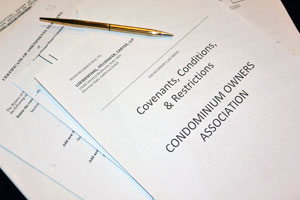LHC Newsletter Vol 9, No. 4
“Insurance and Liability – Keeping Your Association Out of Court”
By: David A. Loewenthal, Esq.
Loewenthal, Hillshafer & Carter, LLP
Insurance, absolutely necessary and required for all common interest developments, but rarely understood. Boards of Directors need to understand what happens when a Homeowners Association fails to have proper general liability insurance, directors and officers insurance, and/or property insurance to cover a claim. In those instances, the Association is left to potentially pay for the damage, defend itself with respect to any claims and in the event of an adverse result be responsible to pay the judgment. What is not commonly understood is how does an Association, its Board of Directors, and members protect themselves through insurance and what are your responsibilities to the insurance carrier in the event of a claim.
The purpose of this article is not to delve into the various types of available insurance policies, including comprehensive general liability, directors and officers, property damage, flood, earthquake, loss assessment, etc. The type, nature and extent of insurance that an Association is to procure is generally dealt with in the Association’s Declaration of Covenants, Conditions and Restrictions as well as in various Civil Code sections contained within the Davis-Stirling Act. Rather, this article will focus on issues such as statutory requirements for insurance, tendering of claims, limitations on individual liability based upon the nature and type of insurance, etc.
At the outset, when the Association is prepared to procure insurance, it is essential that the per occurrence amount of coverage is sufficient to protect the members and the Board of Directors from individual liability by procuring sufficient insurance.
Civil Code section 5805 entitled “Limitation of Member Liability” states as follows:
“(a) It is the intent of the legislature to offer civil liability protection to owners of the separate interests in a common interest development that have common area owned in tenancy-in-common if the Association carries a certain level of prescribed insurance that covers a cause of action in tort.
(b) Any cause of action in tort against any owner of a separate interest arising solely by reason of an ownership interest as a tenant-in-common in the common area of the common interest development shall be brought only against the Association and not against the individual owners of the separate interest, if both of the insurance requirements in paragraphs (1) (2) are met:
(1) The Association maintained and has in effect for the cause of action, one or more policies of insurance that include coverage for general liability of the Association.
(2) The coverage described in paragraph (1) is in the following minimum amounts:
(A) At least two million dollars ($2,000,000) if the common interest development consists of one hundred (100) or fewer separate interests.
(B) At least three million dollars ($3,000,000) if the common interest development consists of more than one hundred (100) separate interests.
As such, and pursuant to Civil Code section 5805, individual owners of a separate interest in a common interest development have civil liability protection as long as the Association has procured liability insurance in the minimum amounts set forth above. A failure by the Association to procure such insurance minimums could open up the individual owners to potential personal liability.
Similarly, Civil Code section 5800 entitled “Limitation of Officer and Director Liability” generally acts in the same manner. This section states as follows:
“(a) A volunteer officer or volunteer director of an Association that manages a common interest development that is exclusively residential, shall not be personally liable in excess of the coverage of insurance specified in paragraph (4) to any person who suffers injury, including, but not limited to, bodily injury, emotional distress, wrongful death, or property damage or loss as a result of the tortious act or omission of the volunteer officer or volunteer director if all of the following criteria are met:
(1) The act or omission was performed within the scope of the officer’s or director’s association duties.
(2) The act of omission was performed in good faith.
(3) The act of omission was not willful, wanton, or grossly negligent.
(4) The association maintained and had in effect at the time the act or omission occurred and at the time a claim was made one or more policies of insurance that shall include coverage for (A) general liability of the Association and (B) individual liability of officers and directors of the Association for negligent acts or omissions in that capacity; provided that both types of coverage are in the following minimum amounts:
(A) At least five hundred thousand dollars ($500,000) that the common interest development consists of one hundred (100) or fewer separate interests.
(B) At least one million dollars ($1,000,000) if the common interest development consists of more than one hundred (100) separate interests.”
It is important to note that with respect to the limitation of officer and director liability, it does not apply to an owner who owns more than two (2) separate interests in the common interest development. In addition, this provision does not limit the liability of the Association for its negligent acts or omissions or for any negligent act or omission of an officer or director of the Association.
What is important to understand with respect to the insurance minimums identified above for both general liability as well as directors and officers is the difference between the limits per occurrence versus aggregate limits. The statutory coverage requirement pertains to the amount per occurrence. An occurrence is any one singular event. An aggregate amount is generally for a specific time period, such as the policy period and is for the total claims made during that policy period. A commercial umbrella policy along with an underlying policy of insurance as long as the coverages are co-extensive as to the type, nature and extent of coverage should satisfy the per occurrence requirement.
As part of an Association’s Annual Disclosure to the Membership, Civil Code section 5300(b) (9) also require the Association to disclose to the membership not less than thirty (30) days and not more than ninety (90) days prior to the beginning of the Association’s fiscal year a summary of the Association’s insurance policies including identifying the name of the insurance company; the type of insurance (general liability, earthquake, directors and officers, etc.), the policy limits including per occurrence and aggregate and the amount of any deductible. To the extent that the Association cancels a policy of insurance, the policy is not renewed, or the Association makes a substantial change in the type of coverage including, most notably, any modification in the deductible, the Association has an obligation to notify its members as soon as reasonably possible of such changes (Civil Code section 5810).
One of the most frequently asked questions with respect to insurance is when the Association should notify the carrier of a claim. Though there is not necessarily any hard and fast rule as to when that exact moment of triggering the obligation to notify the carrier is required, it is important to understand that all policies of insurance have a cooperation clause and a duty to timely notify the carrier of any potential claim. A failure to timely notify the carrier of a claim can lead to the carrier potentially denying the claim as being untimely tendered.
At a minimum, a Board of Directors should err on the side of caution and immediately notify the carrier as to all actual or potential claims if somebody has been injured on the property; someone has threatened to sue the Association; a unit has suffered property damage; the Association has been contacted by an attorney representing a homeowner, tenant, or third party, claiming damage and/or injury. Such claims need to be immediately tendered to the carrier.
Though you may initially put your carrier on notice telephonically, it is important to confirm your notification in writing so as to avoid any future dispute as to when the Association actually notified the carrier of the claim. You should also follow up with the carrier to confirm that they have assigned the claim to an adjuster and that the adjuster is timely investigating the claim. In the event of a lawsuit, where the Association’s general counsel is defending the Association from a claim, insurance carriers are not responsible to reimburse the Association for attorneys fees for time and/or work performed prior to the date of tender of the claim to the carrier. Thus, an early tender increases the likelihood of obtaining reimbursement for attorneys fees and costs. Also, in tendering the claim, the Association should make it clear that they are seeking both a defense and indemnity for the claim. Remember, it is better to report a potential claim early versus too late wherein the failure to timely report the claim to the carrier could be become a basis for their denial of your claim.
Not only does an Association have to make sure that they carry the proper minimum amounts of coverage, both general liability and directors and officers, but the deductible for property damage claims must also be thoughtfully considered. The deductible effects the ability to have insurance coverage for certain claims, i.e., does the claim exceed the deductible? However, excessive claims can increase insurance premiums or lead to the Association being non-renewed by a carrier. Specifically, the deductible is the amount of the damage that the insured is obligated to cover prior to any payments by the insurer. As an example, if the property damage deductible is five thousand dollars ($5,000) and the total amount of damage is fifteen thousand dollars ($15,000), then, and subject to potentially other insurance issues such as actual cash value versus replacement cost value, etc. the insurer would generally pay ten thousand dollars ($10,000).
Generally, the deductible is paid by the Association, unless the loss or claim was caused by the member/owners. Some Associations make the owner responsible for the deductible unless the Association was negligent. The issue with the latter position is that a common area plumbing pipe break, which causes unit damage, may not be as a result of the negligence on the part of the Association; however, the pipe is generally an Association common area component that it is responsible to maintain, repair and replace. As such, requiring an owner to pay the deductible may be inequitable.
Historically, Boards of Directors attempted to maintain low deductibles thus allowing most claims to go through to have some amount of insurance coverage. However, as claims histories rose, thus increasing insurance premiums or leading to policy non-renewals, many Associations started to increase the deductible amount thus decreasing the number of claims and/or the amount of claims payment. Unfortunately, many sets of CC&R’s specify a specific maximum insurance deductible; therefore, a Board raising the deductible above a mandated amount, without amending the CC&R’s, is in fact violating the CC&R’s. Thus, prior to increasing the deductible in order to attempt to limit the amount of claims, a Board needs to review its governing documents to confirm that there is no predetermined maximum deductible amount within those documents.
In addition to the deductible issue, Boards often attempt to modify the extent of coverage afforded. Generally, most standard policies of insurance for a condominium are designed to cover the entirety of the structure, including fixtures and appliances, but not cover personal property, contents and betterments. A Board of Directors in its attempt to lower insurance premiums may attempt to change from a fully inclusive policy to a bare walls policy. A bare walls insurance policy would generally not cover items such as finish flooring, cabinetry, appliances, fixtures, etc. In a bare walls policy, the individual owner would be responsible for the noninsured items. However, if a Board seeks to change its insurance coverage, from an all-inclusive policy to a bare walls policy, it is imperative that the Board review its governing documents to confirm the type, nature and extent of the insurance that the Association is obligated to procure. If the CC&R’s require the Association to have an all-inclusive policy of insurance then the Association would need to amend its CC&R’s prior to procuring a bare walls policy.
With respect to management companies, insurance protection and potential liability there are two distinct issues. The first involves errors and omissions claims against management companies for not properly procuring adequate insurance for the association. This could be in the form of failing to obtain minimum general liability and/or directors and officers insurance coverage to meet the Civil Code minimum standards identified above. It could also be in the form of recommending and agreeing to insurance deductibles that are greater than allowed under the associations Declaration or recommending and agreeing to procure insurance that does not properly insure the structure in compliance with the Declaration, such as only obtaining bare walls coverage when the entire structure, including interior finishes, are to be covered. Depending upon the facts and circumstances, an association may possibly bring a claim against the management company for those negligent acts/omissions.
Another issue for management companies is when an association fails to have the management company named as an additional insured under its general liability insurance policy which generally is required under most management contracts. The mere fact that a management contract requires the association to have the management company named as an additional insured does not, in and of itself, require the insurance carrier to provide insurance coverage to the management company in the event of a claim, if the management company was not actually named as an additional insured under the policy of insurance. As such, management companies should always be reviewing the policies of insurance and renewals to confirm that they are being identified as an additional named insured.
Finally, and importantly, associations, boards of directors and managers need to understand that insurance does not necessarily equate to liability/responsibility or vice versa. Specifically, an associations insurance may be far greater in coverage than what the Declaration actually requires. This is not uncommon in a condominium insurance policy. As an example, the Declaration may not require coverage for damage to separate interest items, within a condominium unit, such as cabinets, finished flooring and painting; however, the policy of insurance may in fact cover those items.
Insurance is one of the most complicated areas affecting common interest developments. As such, it is important that associations and managers use qualified experienced insurance brokers who are well-versed with common interest developments and the insurance required therein.


